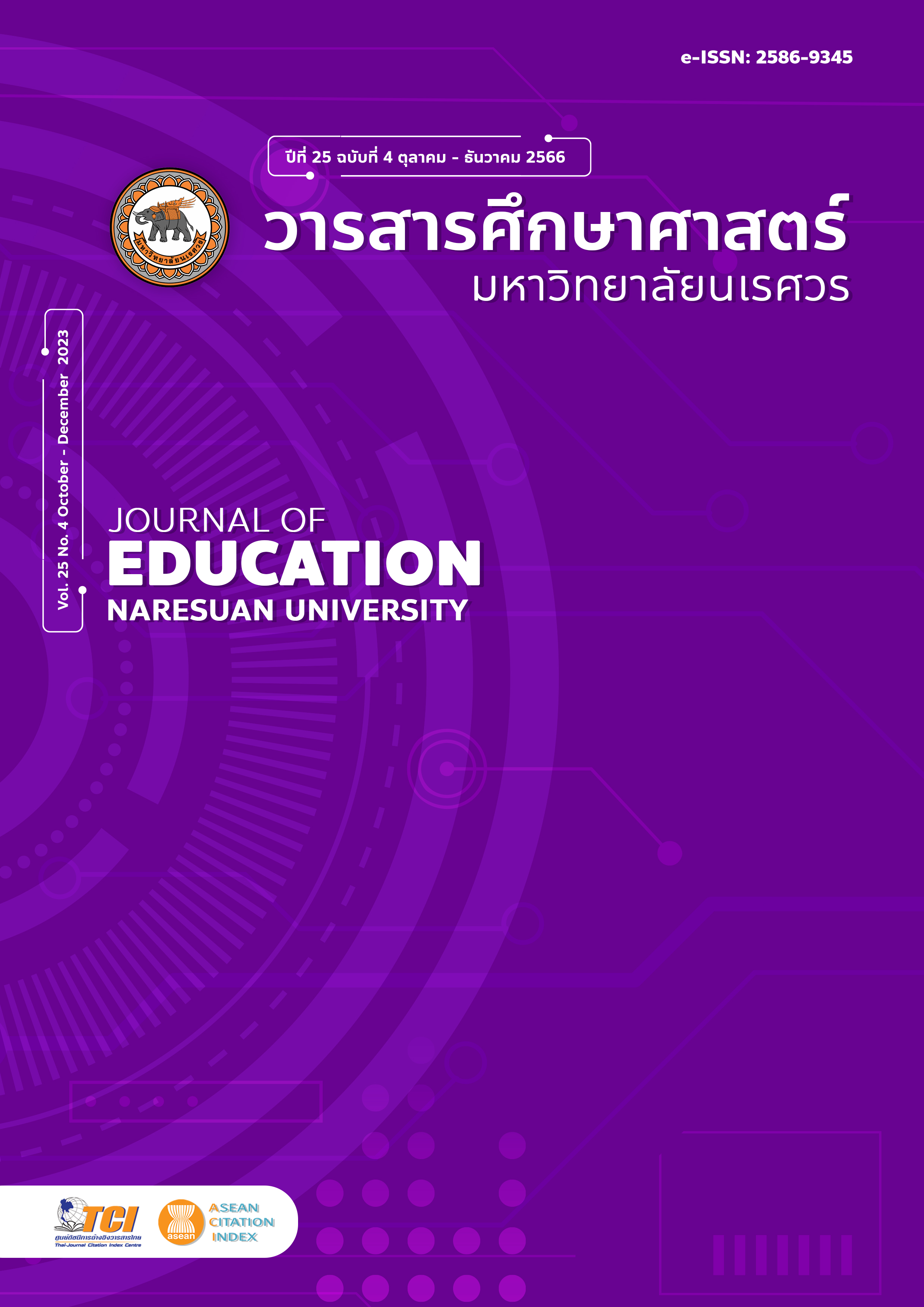THE PRIORITY NEEDS INVESTIGATION FOR CURRICULUM DEVELOPMENT OF INNOVATIVE ARTS FROM LANNA CULTURAL CAPITAL FOR YOUTHS USING DESIGN THINKING
Main Article Content
Abstract
This research aimed to investigate the priority needs for curriculum development of innovative arts from Lanna cultural capital for youths using design thinking. The sample groups used in this research consists of 1) 400 youths in upper-northern, Thailand. 2) Five design thinking experts. 3) Five entrepreneurs of innovative arts from Lanna cultural capital. Research instruments were needs questionnaire and structured interview protocols. The quantitative data were analyzed using percentage, mean, standard deviation, Modified Priority Needs Index (PNIModified), and the qualitative data were analyzed using content analysis. The research results revealed the priority needs for curriculum development of innovative arts from Lanna cultural capital for youths using design thinking consists of five areas in order of modified priority needs index from the highest to the lowest as follows; 1) The applying knowledge and skills to benefit others (PNIModified = 0.350). 2) Knowledge of design thinking (PNIModified = 0.321). 3) Ability to create innovation (PNIModified = 0.297). 4) Knowledge of Lanna cultural capital (PNIModified = 0.292). 5) Teaching and learning management models (PNIModified = 0.258). In addition, the approach to developing a research finding - based curriculum is that the curriculum should be a cross-disciplinary integrated model that encourages experience in design thinking skills to create innovative arts from cultural capital by means of collaborative learning, fieldwork, along with promoting lifelong learning through cooperation from creative economy agencies.
Article Details

This work is licensed under a Creative Commons Attribution-NonCommercial-NoDerivatives 4.0 International License.
The owner of the article does not copy or violate any of its copyright. If any copyright infringement occurs or prosecution, in any case, the Editorial Board is not involved in all the rights to the owner of the article to be performed.
References
Booranasing, W. (2001). Curriculum management (2nd ed.). Bangkok: Ramkhamhaeng University Press. [in Thai]
Brown, T. (2009). Change by design : how design thinking transforms organizations and inspires innovation. New York: Harper Business.
Chonpracha, S. (2014). Adult learning theory : what teachers teach adults to learn. Journal of Education Prince of Songkla University, 25(2), 13 - 23. [in Thai]
Division of Community Industry Development. (2016). Thai attraction in contemporary ways: a prototype collection of cultural capital and wisdom products in 2014 - 2015. Bangkok: Department of Industrial Promotion. [in Thai]
Jalinus, N., Syahrill, A., & Nabawi, R. A. (2019). A comparison of the problem-solving skills of students in PjBL versus CPjBL model: an experimental study. Journal of Technical Education and Training, 11(1), 36 – 43.
Kaufman, R., & English, F. W. (1979). Needs assessment : concept and application (2nd ed.). Englewood Cliffs, NJ: Educational Technology Publications.
Keativipak, K. (2017). Industrial crafts design framework (grow - reborn). Journal of Fine and Applied Arts, Khon Kaen University, 9(2), 333 - 366. [in Thai]
Kijima, R., & Sun, K. L. (2021), ‘Females don’t need to be reluctant’: employing design thinking to harness creative confidence and interest in steam. International Journal of Art & Design Education, 40(1), 66 - 81.
Koh, J. H. L., Chai, C. S., Wong, B., & Hong, H. Y. (2015). Design thinking for education: conceptions and applications in teaching and learning. Singapore: Springer.
Korsukthaweekhoon, C. (2018). The studying of entrepreneurial motivation and intention of higher education students in Thailand (Master thesis). Pathum Thani: Bangkok University. [in Thai]
Kuntonbutr, C., Combs, H., & Konosu, T. (2018). The effect of innovation-based orientation on business growth through human resources management and new product development. Srinakharinwirot Research and Development (Journal of Humanities and Social Sciences), 10(20), 17 – 28. [in Thai]
Lenkauskaite, J., Colomer, J., & Bubnys, R. (2020). Students’ social construction of knowledge through cooperative learning. Sustainability, 12(22), 1 – 24.
Lyncha, M., Kamovich, U., Longvaa, K. K., & Steinert, M. (2021). Combining technology and entrepreneurial education through design thinking: students' reflections on the learning process. Technological Forecasting and Social Change, 164, 1 – 11.
Meyer, M. W., & Norman, D. (2020). Changing design education for the 21st century. The Journal of Design, Economics, and Innovation, 6(1), 13 – 49.
Office of Small and Medium Enterprise Promotion. (2012). Cultural treasures to creating value added on the creative economy. Bangkok: Ministry of Industry. [in Thai]
Office of the National Economic and Social Development Council. (2018). Northern development plan 2017-2022 (revised edition). Retrieved December 12, 2020, from shorturl.asia/wIeXT [in Thai]
Pattanabunpaiboon, P. (2013). Creative space workshop: crafts innovation by the support arts and crafts international centre of Thailand (SACICT). Retrieved December 12, 2020, from shorturl.asia/xYBh0 [in Thai]
Rouse, W. (1993). Human - centered design: concept and methodology. J. SICE, 32(3), 187 - 192.
Seidel, V. P., Marion, T. J., & Fixson, S. K. (2020). Innovating how to learn design thinking, making, and innovation: incorporating multiple modes in teaching the innovation process. INFORMS Transactions on Education, 20(2), 73 – 84.
Silanoi, L. (2017). How to use the appropriate statistical formulas for determining the sample size for quantitative research designs in the humanities and social science study. Journal of Research and Development Buriram Rajabhat University, 12(2), 50 - 61. [in Thai]
Sutthirat, C. (2013). Curriculum development implementation. Bangkok: V Print. [in Thai]
Tepsing, P. (2014). The status of products in new social ways and teaching guideline of product design. Academic Journal, Faculty of Architecture Khon Kaen University, 13(1), 30 – 40. [in Thai]
Thailand Creative and Design Center. (2018). TREND 2019 TCDC NOW AGE: manifesto and action. Retrieved December 12, 2020, from shorturl.asia/F9mbo [in Thai]
Thailand Creative and Design Center. (2019). TREND 2020 TCDC Positive power. Retrieved December 12, 2020, from shorturl.asia/7ldZh [in Thai]
Tourism Authority of Thailand. (2019). Action plan of tourism authority of Thailand fiscal year 2019. Retrieved December 12, 2020, from shorturl.asia/2krHU [in Thai]
Tripopsakul, S., & Pichyangkul, C. (2018). Factors influencing youth entrepreneurs in Thailand. Nida Business Journal, 22, 44 – 60. [in Thai]
Wongwanich, S. (2019). Needs assessment research (4th ed.). Bangkok: Chulalongkorn University Press. [in Thai]


